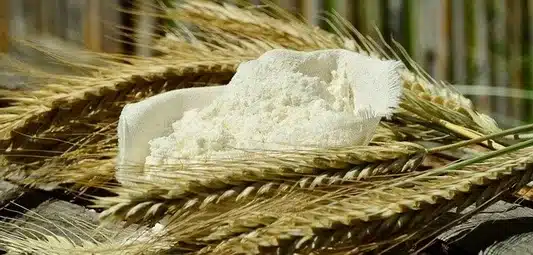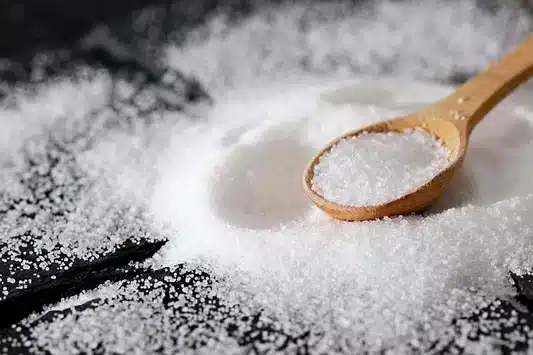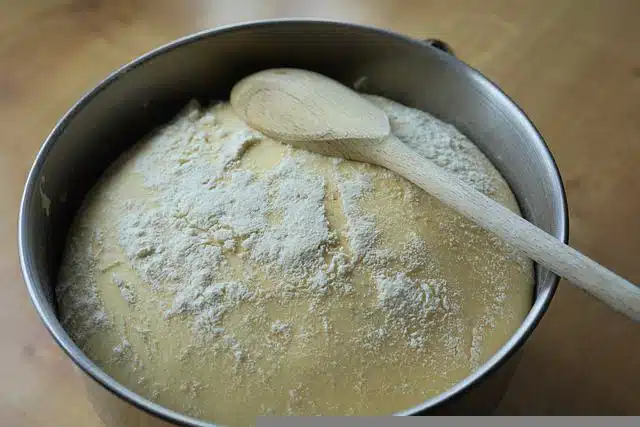Cereals have been present in the human diet since ancient times. Even today, bread made from them is one of the staple foods in most parts of the world. The technology of making bread has changed over time, but its essential ingredients remained the same.
You don’t need a lot of ingredients to bake high-quality, tasty bread. The purpose of this post is to explain what ingredients are essential in bread making.
The main ingredients of bread are wheat flour, water, salt, and a leavening agent, which can be yeast or a sourdough starter made of water and flour. • The starch and protein content of wheat flour gives the bread its structure and bulk. • Water is necessary for the swelling of gluten and starch, and its conversion to steam during baking helps the leavening of the bread. • Salt is a flavoring agent, but it also strengthens the structure of gluten and starch and influences fermentation. • The leavening agent produces carbon dioxide gas, which is necessary for bread leavening. It also affects the taste of the bread.
In addition to the main ingredients listed above, bread can also contain other components, such as seeds, flakes, or spices.
In the case of factory-made bread, the use of various additives became necessary due to the shortened preparation time. Let’s now take a detailed look at the function of each ingredient in the bread-making process.
1. Flour
Flour is an important ingredient in baking bread, which is made from ground cereals. The first flours made by man were probably created by roasting and grinding wild grains. Medieval bakers started to use sifted white wheat flour for making bread.
The parts of the wheat grain are the bran, the germ, and the endosperm. White flour is made by grinding only the endosperm, which is rich in proteins and starches.
For home use, all-purpose flour is the most common, but bakeries use a variety of flour with different properties and qualities. The quality of the flour depends on the type of grain and its growing conditions. It is important to choose the right flour for different baked goods.
The bread yield depends on the type and quality of the flour, which means how much bread we get compared to the amount of flour used. This is expressed as a percentage and ranges between 150-170%.
Flours made from wheat are the best for making leavened bread, as they contain the largest amount of proteins necessary for the structure of the bread. Flours with a protein content between 10.5 and 12% are most suitable for home use.
Whole grain wheat flour contains the whole grain of wheat, together with the bran and germ. Used alone, it produces a heavy, dense bread dough despite containing gluten. Therefore, it is mostly used mixed with white flour.
We can make high-quality, well-risen bread from a mixture of whole grain and white wheat flour mixed in equal proportions.
What are the main components of flour?
Gluten
Strong flours made from hard wheat are best for leavened bread. They contain large amounts of glutenin and gliadin. These are proteins from which gluten develops as a result of moisture and mixing. Only flours made from wheat contain the right amount and quality of gluten to make high-quality leavened bread.
Starch
White flour also contains 68-76% starches, which make up the bulk of the bread.
Starches are carbohydrates made from simple sugars. A small part of these breaks down into sugar as a result of grinding, which feeds the yeast in the bread dough.
Starch functions as a binding agent during the kneading of the dough. It absorbs a lot of water and swells. During baking, the starch forms a brown, solid crust on the bread.
Enzymes
Flour also contains enzymes, the most important of which is amylase. It breaks down the starch and allows fermentation without adding sugar to the dough.
Other types of flour
The flour of other cereals contains no gluten at all or only a small amount. Therefore, in the preparation of leavened bread, they are mostly mixed with wheat flour. The flour of these cereals, such as corn flour (maize), is suitable for making various flatbreads.
Corn flour (Maize)
Corn does not contain gluten at all, which is important information for people with gluten sensitivities. However, it contains other useful proteins. Cornmeal is mostly made by grinding only the grain, as the germ has too much oil. Corn flour can be finely ground or coarse, which affects the structure of the bread.
Rye flour
Rye flour does not contain the right amount and quality of gluten to make leavened bread, so it is mostly used mixed with white wheat flour. 20-40% of the white wheat flour can be replaced with rye flour to make nicely risen bread.

2. Water
Prehistoric people mixed toasted and stone-ground grains with water into a paste. When this paste was baked on heated stones, bread was created.
The method of making flatbreads and tortillas, which are popular in many parts of the world, does not differ much from their prehistoric predecessors.
Water is an important part of bread, which is necessary for the development of gluten and helps the starch to swell. The amount of water needed for the dough depends on the protein content of the flour. In some enriched bread formulas, such as brioche, milk is used instead of water.
The water used for bread dough should not be hotter than 45°C, because then the fermentation of the yeast will stop and it will have a bad effect on the quality of the bread.
During baking, the water turns into steam due to the heat, which contributes to the rising of the bread. You may wish to read what happens if you don’t add enough water to the bread dough.
3. Salt
Salt is used to flavor the bread, but it is also needed for the proper structure of the dough.
Salt contributes to the swelling of starch and gluten and the development of their structure. Because it helps retain water, the bread dough rises better.
Another function of salt is that it slows down fermentation and thus prevents the bread dough from over-rising and the disproportionate formation of air bubbles.
Salt limits the action of the yeast, so it is important to make sure that it does not come into direct contact with the yeast when making the dough. It is best to mix the salt with the flour and add it to the bread dough.

4. Leavening agents
Leavening agents produce carbon dioxide gas, which increases the volume of the bread and affects its texture.
Air, which is introduced into the dough by mixing, is important for the leavening of bread. The leavening gases fill these air bubbles and expand them due to the heat. The walls of these air bubbles are mostly made up of gluten, which solidifies and helps keep the shape of the bread.
Sourdough starter
In the case of the first bread, sourdough was probably created by chance. The water and grain mixture left in the air began to ferment under the influence of microorganisms in the air, which are lactic acid bacteria and so-called wild yeasts.
The sourdough starter is a mixture of water and flour, which is allowed to ferment under the influence of microorganisms in the air. Carbon dioxide and acids are produced in the dough due to wild yeasts.
As the name suggests, a sourdough starter is acidic. Therefore, bread made with it has a more intense flavor and a better texture due to the longer fermentation time. Bread made with a sourdough starter can be kept fresh longer than those made with yeast.
Over time, people learned to set aside some of the leavened bread dough for the next day and use it to leaven a new batch of bread dough. This piece of dough from the previous day is known as scrap dough.
Yeast
The conscious use of yeast in bread-making began in ancient Rome, with the addition of beer foam to bread dough. The fermentation of beer results in the creation of yeast. Yeast fermentation also determines the taste of the bread.
Yeast is available in three forms:
- Fresh yeast is pressed into different-sized cubes and wrapped in foil to prevent it from drying out. It must be kept in the refrigerator until use, as it dries out and spoils easily. If you intend to store the fresh yeast for a longer period, you can freeze it. It is usually added to bread dough dissolved in lukewarm water.
- Dried yeast is in powder form, which must be mixed with water before use to activate it. However, the yeast is often damaged during the production process, which can affect the quality of the finished product.
- Instant yeast, which is also in powder form, does not need to be activated with water before use but is added to the dough mixed with flour. Its quality is similar to that of fresh yeast, but it ferments faster.
Yeast is a living organism that causes fermentation. This means that the zymase enzyme in it breaks down the sugar into carbon dioxide and ethyl alcohol. The carbon dioxide gas causes the leavening of the bread, and the alcohol completely evaporates due to the heat.
The sugar needed for yeast fermentation can come from two sources:
- The first source of sugar comes from the starches of wheat flour, which are converted into sugar by the enzymes present in the flour.
- The other option is added sugar.
Yeast is extremely sensitive to temperature. Fresh yeast should be stored in the refrigerator until use. The ideal temperature for yeast to leaven bread is between 20-30°C.

While on the subject of yeast, you may also wish to find out at what temperatures yeast cells die during baking.
Additional ingredients and flavorings used in bread making
The ancient Greeks already added honey and oil to bread, which became similar to cakes. In addition to the main ingredients, whole or ground grains and flakes, as well as various spices can be added to the bread.
Sugar
As I mentioned above, the enzymes in wheat allow fermentation without added sugar. However, sugar is a commonly used ingredient in bread and pastries. But what is the role and effect of sugar in bread?
- Sugar feeds the yeast, thereby promoting leavening.
- Since the sugar caramelizes under the influence of heat, it contributes to the formation and browning of the crust of the bread.
- Sugar is a hygroscopic substance, which means that it can absorb and retain moisture. Therefore, baked goods containing sugar do not dry out as quickly.
Wide-scale industrial production of bread began in the 1950s and introduced the use of various additives. These were necessary to improve the texture and taste of the bread due to the significantly shortened dough preparation time.
Final thoughts
So, the main ingredients for making bread are flour, water, salt, and a leavening agent. All of them play an important role in the preparation and baking of bread and have an impact on the quality of the finished product.
- The starch content of the flour gives the bread bulk, and it also contains proteins that allow the bread to rise.
- The water bound by the flour turns into steam during baking, which causes the bread to rise.
- The leavening agent, which can be yeast or sourdough, enables the bread dough to rise by producing carbon dioxide gas.
- Salt adds flavor to bread, helps leavening, controls fermentation, and affects the browning of the crust.
There are currently various types of bread available, such as sourdough, yeast, and quick bread. Bread can be prepared on an industrial scale or at home using a bread machine or an oven. In addition to the essential ingredients, it may also include various other ingredients and additives.

